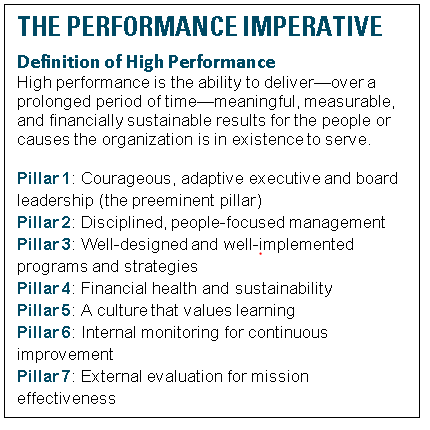Note from Beth: I’m honored to be a member of the Leap Ambassadors Community, a group of people in the nonprofit sector who care deeply about high performance. A recent work product from this community includes “Small, But Mighty,” created by a small group led by Debra Natenshon and Karen Walker, the guest post authors. Often, we think of “high performance” as something only for large organizations, but smaller nonprofits can apply the ideas too. As a member of the NTEN Board, I used this framework to help us work through our performance evaluation process.
Small, But Mighty: A Resource for Small Nonprofit Leaders by Debra Natenshon and Karen Walker

In 2015, a group of nonprofit leaders, funders, consultants, and researchers passionate about the need to foster high performance in nonprofit organizations collaboratively developed The Performance Imperative: A Framework for Social-Sector Excellence (PI). Their intention was to create a guide for nonprofit leaders who wanted to ensure that their organizations provided high quality, sustainable results for the people or causes they served. The PI was explicitly designed for nonprofits with budgets over $3 million because those organizations serve the vast majority of people receiving nonprofit services in the US. Strategically, this decision made a lot of sense because undertaking the work of the PI requires significant resources, which are often unavailable to smaller organizations.
At the same time, many in the group, the Leap Ambassadors Community, were passionate about meeting the needs of small nonprofits, such as youth development programs, environmental programs, churches, arts programs, and others. Actually, according to the Urban Institute, 88% of nonprofits had revenue between $100,000 and $3 million in 2015! These nonprofits fill important niches in communities, often maintain close relationships with their beneficiaries, and serve as incubators for innovative ideas. Therefore, we formed a working group to develop an introduction to the PI that would inspire small nonprofits to undertake the journey to high performance.
The result, Small, But Mighty: The PI for Small Nonprofits, is now available. We know that small nonprofit organizations face resource constraints that limit the extent to which they can work on the seven disciplines that constitute the PI, but we provide examples of how organizations can begin their journey toward excellence even with limited budgets.
For example, More Than Words in Boston is a social enterprise that provides youth who are in the foster care system, homeless, or out of school with the developmental supports they need to thrive along with employment and educational services to prepare them for the future. No longer small, with a budget over $5 million, the organization began work to become a high-performing nonprofit in 2007. At the time, its budget was $300,000 and the organization earned $130,000 from its social enterprise. That year, the organization developed the first draft of its theory of change and began to monitor program performance and outcomes. Currently, all the staff collects and uses information to manage the social enterprise and support the youths’ progress. According to Jennifer Herbert, the organization’s chief operating officer who has been with the organization for 9 of its 14 years:
“More Than Words has been a data-driven organization since its inception. Jodi Rosenbaum, our CEO and founder, created a culture among staff that we use data in our daily work to improve youth’s outcomes and the staff’s performance. It is literally woven into the fabric of how we work to empower youth to achieve outcomes in education, employment and self-efficacy.”
Even when small, the work of More than Words leadership and staff reflected at least four of the PI’s pillars: courageous and adaptive leadership, a focus on well-designed programs and strong implementation, a culture of learning, and internal monitoring for continuous improvement. In the years since, they have strengthened their capabilities in those and other areas.
As our small nonprofit working group thought about how to make the PI feasible for small nonprofits, we wrestled with several hard questions. Below, we share some that came up repeatedly.
- How small is small? We set the broadest range we could—organizations with budgets between $100,000 and $3 million.
- Should we include all seven pillars? Yes, but only certain types of external evaluation (Pillar 7) can be undertaken by small nonprofits, namely formative evaluation. Experimental impact evaluations are too expensive.
- Should organizations start with one pillar vs. another? This is a critical question for small nonprofits with limited resources. While it’s probable that even large nonprofits can’t address all pillars at once, it’s indisputable that small nonprofits must prioritize the type of organizational development the PI requires. We suspected that Pillar 1 (Courageous, adaptive executive and board leadership) might make sense as a starting point, but small organizations have also undertaken this work when crises threatened their organizational viability. Handling those challenges meant that they also needed to address other pillars.
- Should the document focus only on nonprofits that hope to get larger? The question here was, “Why appeal to organizations that are only serving a few people?” We ultimately decided that small organizations often serve critical parts of our communities. Additionally, they can deepen their impact with those they serve, even if their numbers of beneficiaries don’t increase.
The purpose of the resulting document is to entice small nonprofit leaders to consider how they might use the PI in their own work. This short document is a call to action. We hope you’ll read it and let us know what you think about Small, But Mighty!
Debra Natenshon, Principal, DBN & Associates
Karen Walker, Senior Research Fellow, Child Trends

Leave a Reply